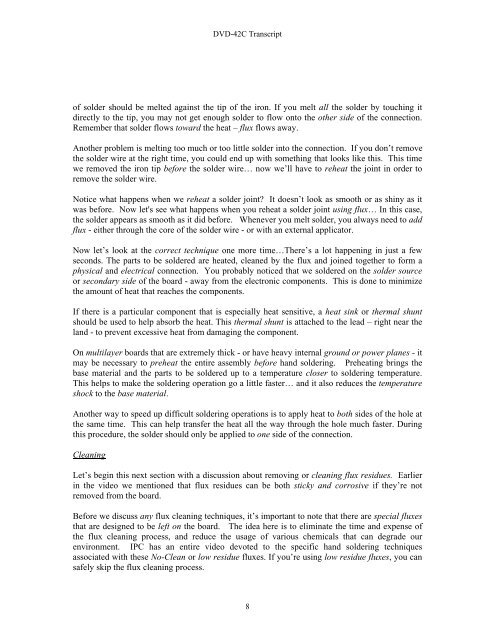DVD-42C Hand Soldering for Through-Hole Components
DVD-42C Hand Soldering for Through-Hole Components
DVD-42C Hand Soldering for Through-Hole Components
- No tags were found...
Create successful ePaper yourself
Turn your PDF publications into a flip-book with our unique Google optimized e-Paper software.
<strong>DVD</strong>-<strong>42C</strong> Transcriptof solder should be melted against the tip of the iron. If you melt all the solder by touching itdirectly to the tip, you may not get enough solder to flow onto the other side of the connection.Remember that solder flows toward the heat – flux flows away.Another problem is melting too much or too little solder into the connection. If you don’t removethe solder wire at the right time, you could end up with something that looks like this. This timewe removed the iron tip be<strong>for</strong>e the solder wire… now we’ll have to reheat the joint in order toremove the solder wire.Notice what happens when we reheat a solder joint? It doesn’t look as smooth or as shiny as itwas be<strong>for</strong>e. Now let's see what happens when you reheat a solder joint using flux… In this case,the solder appears as smooth as it did be<strong>for</strong>e. Whenever you melt solder, you always need to addflux - either through the core of the solder wire - or with an external applicator.Now let’s look at the correct technique one more time…There’s a lot happening in just a fewseconds. The parts to be soldered are heated, cleaned by the flux and joined together to <strong>for</strong>m aphysical and electrical connection. You probably noticed that we soldered on the solder sourceor secondary side of the board - away from the electronic components. This is done to minimizethe amount of heat that reaches the components.If there is a particular component that is especially heat sensitive, a heat sink or thermal shuntshould be used to help absorb the heat. This thermal shunt is attached to the lead – right near theland - to prevent excessive heat from damaging the component.On multilayer boards that are extremely thick - or have heavy internal ground or power planes - itmay be necessary to preheat the entire assembly be<strong>for</strong>e hand soldering. Preheating brings thebase material and the parts to be soldered up to a temperature closer to soldering temperature.This helps to make the soldering operation go a little faster… and it also reduces the temperatureshock to the base material.Another way to speed up difficult soldering operations is to apply heat to both sides of the hole atthe same time. This can help transfer the heat all the way through the hole much faster. Duringthis procedure, the solder should only be applied to one side of the connection.CleaningLet’s begin this next section with a discussion about removing or cleaning flux residues. Earlierin the video we mentioned that flux residues can be both sticky and corrosive if they’re notremoved from the board.Be<strong>for</strong>e we discuss any flux cleaning techniques, it’s important to note that there are special fluxesthat are designed to be left on the board. The idea here is to eliminate the time and expense ofthe flux cleaning process, and reduce the usage of various chemicals that can degrade ourenvironment. IPC has an entire video devoted to the specific hand soldering techniquesassociated with these No-Clean or low residue fluxes. If you’re using low residue fluxes, you cansafely skip the flux cleaning process.8

















